For an animal (just) that is 95% water, has no brain and eats / defecates out of the same opening the jellyfish have a surprisingly complex and effective weapon at their disposal. Most species have tentacles loaded with stinging cells called nematocysts. When these stinger cells are triggered the internal pressure builds up to a massive 2,000 psi (136 atmospheres) whereupon it bursts, firing out a toxin harpoon. This is one of the fastest movements in nature and quicker than a bullet [1].
Although evolved to take out prey such as small fish the jellyfish’s venomous sting also has a defensive role. The toxicity to humans varies widely with some stings being mildly irritating and the deadliest being potentially fatal within minutes – these are some of the most venemous animals in the ocean. So, after much research and without further ado, here are the most dangerous jellyfish known to man.
5. Sea Nettle (Chrysaora)
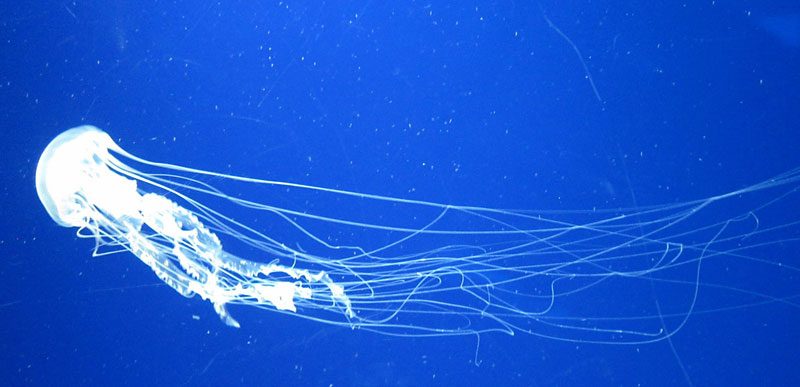 The Sea Nettles are common on both coasts of North America. They are probably best known around the Chesapeake Bay area of the US East coast. Here they aggregate to forming huge blooms (that’s the technical term for a bunch of jellyfish) during the summer months becoming a menace to swimmers. The sea nettles are large jellyfish reaching up to 1ft (30cm) across. They have 24 tentacles [2] which can measure well over 6ft (2m) in length and it is on these that the infamous stingers reside.
The Sea Nettles are common on both coasts of North America. They are probably best known around the Chesapeake Bay area of the US East coast. Here they aggregate to forming huge blooms (that’s the technical term for a bunch of jellyfish) during the summer months becoming a menace to swimmers. The sea nettles are large jellyfish reaching up to 1ft (30cm) across. They have 24 tentacles [2] which can measure well over 6ft (2m) in length and it is on these that the infamous stingers reside.
The sting from a sea nettle can be extremely painful and leave a painful rash on the skin for around an hour [3]. They are not generally dangerous though and medical assistance is very rarely needed. Reports of stings from more exotic Chrysaora species have been more serious.
4.Lion’s Mane Jellyfish (Cyanea capillata)
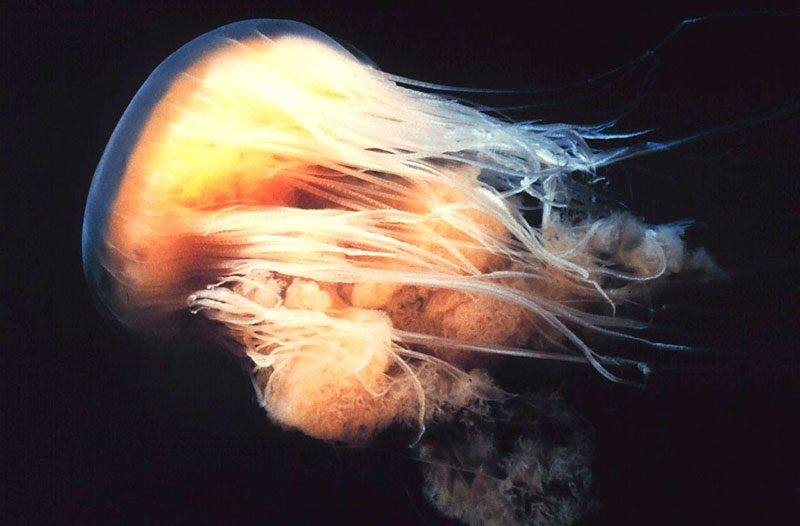 The lion’s mane jellyfish is the largest species known to man. With a bell reaching up to 8 ft (2.5m) or more across and tentacles trailing over 100 ft (30m) these monster jellies can weigh around a quarter ton [4]. They also occur in large swarms meaning a convergence of these on your local beach is going to put it out of bounds. The lion’s mane is a coldwater species and can be found throughout the North Atlantic, including the UK. It also occurs in cooler Australian waters where some lifeguards have allegedly taken to wearing pantyhoses – partly to protect against the sting.
The lion’s mane jellyfish is the largest species known to man. With a bell reaching up to 8 ft (2.5m) or more across and tentacles trailing over 100 ft (30m) these monster jellies can weigh around a quarter ton [4]. They also occur in large swarms meaning a convergence of these on your local beach is going to put it out of bounds. The lion’s mane is a coldwater species and can be found throughout the North Atlantic, including the UK. It also occurs in cooler Australian waters where some lifeguards have allegedly taken to wearing pantyhoses – partly to protect against the sting.
The sting itself can be highly painful and many sources (including National Geographic) describe it as being potentially fatal. What is known is that, like most jellyfish, the stings remain active for a considerable time after death [5]. In a recent incident at a beach in New Hampshire, USA, a single washed up lion’s mane jellyfish broke up and the fragmented tentacles stung a reported 150 people [6].
3. Portuguese Man o’ War (Physalia physalis)
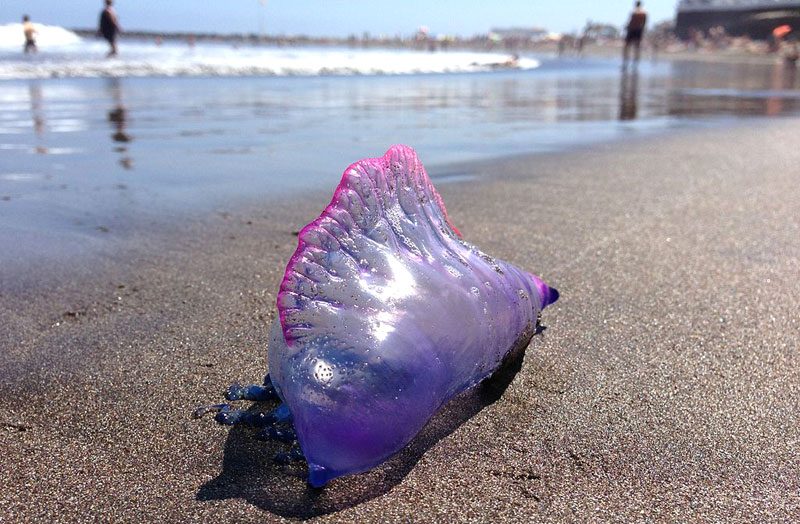
Strictly speaking the Portuguese Man o’ War, or bluebottle, is not a true jellyfish. It isn’t actually even a single animal. It is actually a whole colony of organisms working together in peace and harmony [7]. The name comes from the air filled bladder that acts as a float and sail – this was thought reminiscent of the 17th century naval ships called men-of-war. I think the Portuguese bit also comes from the ship – I lived in Portugal for a while and never saw any of these critters.
In Australia they call it a blue-bottle because it’s blue. The Man o’ War is found throughout the oceans of the world and has been sighted as far north as Scotland, thanks largely to the warm waters of the Gulf Stream.
The sting of the Portuguese Man o’ War is both serious and common with up to 10,000 stings per annum in Australia alone. The sting itself is characterised by a painful raised whip-like welt across the skin. These can last from an hour to several days. The main risk is from systemic effects of the venom. In severe cases intense pain followed by fever, shock, and impaired heart and lung function leading to possible death may occur [8].
2. Irukandji Jellyfish (Carukia barnesi)
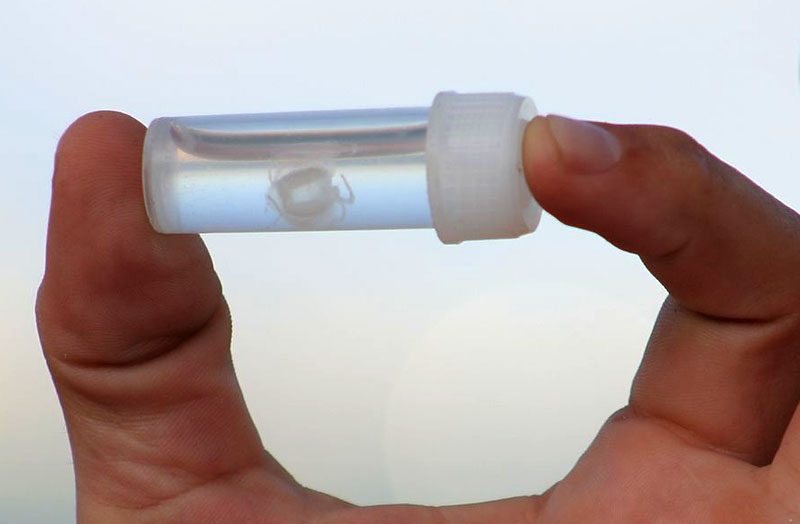 What the Irukandji jellyfish lacks in size it makes up for in the power of its venom. The name is derived from the Irukandji people of North Australia, as this is where the jellyfish was first observed. However, it appears to be much more widespread than this with specimens allegedly found as far away as the British Isles [9].
What the Irukandji jellyfish lacks in size it makes up for in the power of its venom. The name is derived from the Irukandji people of North Australia, as this is where the jellyfish was first observed. However, it appears to be much more widespread than this with specimens allegedly found as far away as the British Isles [9].
Measuring only 5mm (0.2 ins) across and with tentacles less than 1 metre (3 ft) it is one of the smallest members of the box jellyfish family. The venom though is insanely powerful; it is reputedly the most venomous animal toxin on earth, over 100 times more powerful than that of the cobra [10]. In addition to this the Irukandji Jellyfish is unique in having stingers on its bell as well as tentacles.
The only reason this critter isn’t at the top of our list of most dangerous jellyfish is its small size. Despite this the sting is without doubt potentially lethal. Often one sting will not kill as long as appropriate treatment is given. In non fatal stings Irukandji syndrome may develop with delightful symptoms such as excruciating muscle cramps, severe pain in the back and kidneys, burning sensation of the skin and face, vomiting, headache and increased heart rate. Victims have also described a ” feeling of impending doom” [11].
The good news is that apparently, the sting itself isn’t too painful [12]!
1. Box Jellyfish (Chironex fleckeri)
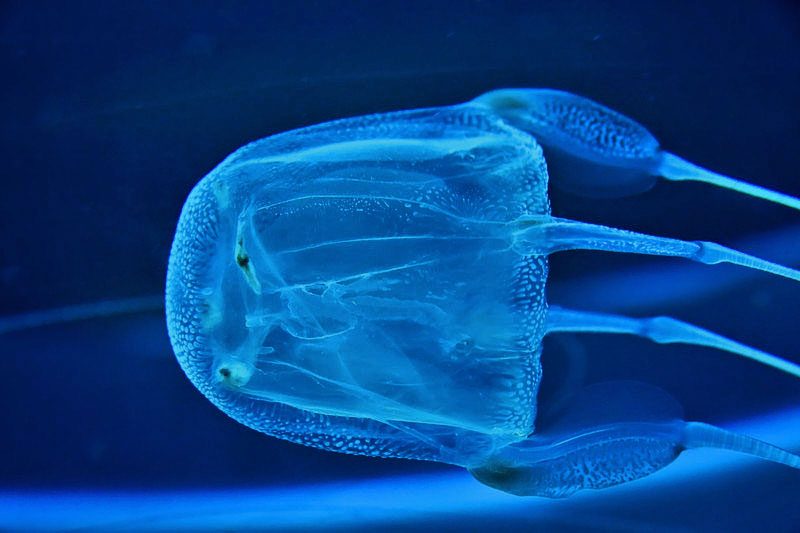 It seems to go without saying that the meanest, most poisonous, and deadliest of all jellyfish inhabits Australia. The variety of box jellyfish known as the sea wasp or marine stinger is widely regarded as one of the most deadly creatures on earth. Along with other box jellies they have been responsible for at least 5,568 deaths recorded since 1954. The Australian variety causes around 1 death a year on average with a further 100 in South East Asia [13].
It seems to go without saying that the meanest, most poisonous, and deadliest of all jellyfish inhabits Australia. The variety of box jellyfish known as the sea wasp or marine stinger is widely regarded as one of the most deadly creatures on earth. Along with other box jellies they have been responsible for at least 5,568 deaths recorded since 1954. The Australian variety causes around 1 death a year on average with a further 100 in South East Asia [13].
As with so many of the deadliest animals it is said that from certain angles there are skull-like marking – in this case on the largely transparent bell. The 15 tentacles can reach up to 3 metres (10 ft) long and each is covered in around half a million venom infused, microscopic darts. It is estimated that each animal contains enough venom to kill 60 adult humans. The venom acts fast too and it can kill within minutes causing cardiovascular collapse. It also attacks the nervous system and skin cells.
The actual sting has been compared to being branded with a red hot iron. It is said that the pain can be so severe that it may result in shock leading to drowning or heart failure on its own. Whilst stings are often survived pain can continue for weeks and there may be permanent scarring resembling whip marks across affected areas [14].
With 24 eyes, four brains and an impressive 60 anal regions (whatever they are) the box jelly fish are definitely an advanced and formidable creature.
Some Jellyfish that aren’t as dangerous as you read elsewhere…
While it is true that by their very nature jellyfish sting, not all are even remotely dangerous. In fact on the deadly scale some stings come in at somewhere between barely discernible and mildly irritating. A good number of jelly fish species don’t even have stings large or powerful enough to penetrate human skin so can be considered completely harmless. The truth is with the exception of a few related species the majority of jellies pose no danger to humans. With this in mind I felt it necessary to debunk some of the misinformation on other websites that all seem to have copied the “facts” from each other.
Moon Jellyfish – mostly harmless
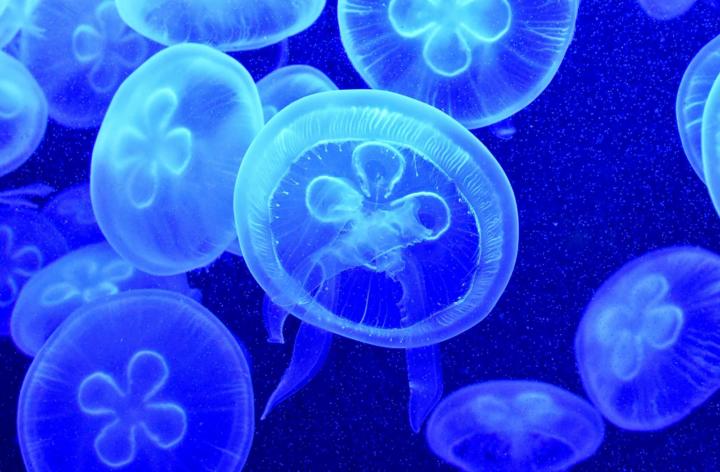
If you have ever seen a jellyfish in an aquarium the chances are it was a moon jelly (Aurelia aurita). Common throughout the world’s oceans these creatures have a bell around the size of a dinner plate. The easiest way to recognize these jellyfish is by the four purple rings which form a kind of clover leaf pattern in the centre of the translucent dome. These are in fact the gonads, and besides these there isn’t a lot going on here – no brain, no blood and no heart.
The moon jellyfish sting is at worst slightly irritating, ranging from a prickly to mildly burning sensation. In general the sting is not even powerful enough to get through human skin, so any claims of this jelly being one of the world’s most dangerous, or even deadly are way overblown. It is likely that they found their way onto other list because they are one of the most commonly encountered jellyfish around the world and therefore swimmers are more likely to encounter them.
Cannonball Jellyfish – not so dangerous
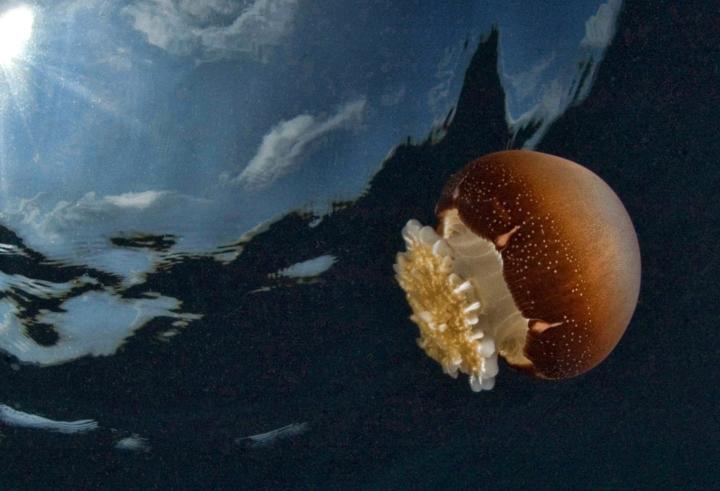
About the size and shape of a cannon ball this jellyfish is also known as the cabbagehead jellyfish. They are found throughout the temperate waters of the North Pacific and along the US Eastern seaboard right down to Brazil. During the summer months they can be extremely common in the coastal shallow waters.
Although the cannonball regularly comes into contact with humans stings are not all that common and rarely anything more than a mild irritant (although it can be quite painful in some cases). However, merely brushing against one of these jellies is unlikely to result in a sting. Where the misconception that these are super-dangerous jellyfish comes from is probably the Wikipedia article which states the toxin can cause cardiac problems in humans such as irregular heart rhythms. This is not that unusual for many species of jellyfish and there is little evidence that a sting from a Cannonball jelly will result in heart problems.
On the other hand humans are probably the Cannonball jellyfish’s main predators. The species is considered something of a delicacy in Japan and other Asian countries. In Georgia it is big business catching the jellies, drying them and shipping them to dinner tables across Asia.
And one last thing…
You may have heard that the best way to treat a jellyfish sting is to pee on it. Well don’t! When you get stung there will often be traces of tentacles bursting with stinger cells left behind on the skin. All these nematocyst cells are primed with venom and ready to go causing even more pain [15]
One thing that is more or less guaranteed to trigger the stingers is freshwater – try rinsing the sting with tap water and you will make things worse. This is because a change in the balance of salts inside and outside the stinger cells will set them off (freshwater has no salts).
So how about fresh pee-pee – that’s got salts and electrolytes and all kinds of stuff in it?! Well, if you are lucky it might be just right and be as effective as seawater at best. However, the chances are it will be too dilute and you’ll be setting off those stingers just as if you had poured tap water over the sting. If you are going to pour anything on make it vinegar as this will not only rinse some of the tentacles away but will deactivate the stinging cells.
References
| ↑1 | Cnidarian internal stinging mechanism | ncbi.nlm.nih.gov |
|---|---|
| ↑2 | Smithsonian Insider: Scientists discover common sea nettle jellyfish is actually two distinct species | insider.si.edu |
| ↑3 | Sea Nettles Factsheet | museum.wa.gov.au |
| ↑4 | Lion’s Mane Jellyfish | americanoceans.org |
| ↑5 | Treatment of Lion´s Mane jellyfish stings | gupea.ub.gu.se |
| ↑6 | Dead jellyfish stings about 150 beachgoers in New Hampshire | edition.cnn.com |
| ↑7 | What is a Portuguese Man o’ War? | oceanservice.noaa.gov |
| ↑8 | Portuguese Man-of-War Sting | www.fairview.org |
| ↑9 | Irukandji jellyfish | en.wikipedia.org |
| ↑10 | Irukandji most venomous but box jellyfish kills faster | www.couriermail.com.au |
| ↑11 | Irukandji Syndrome | www.ncbi.nlm.nih.gov |
| ↑12 | What Is the Worst a Jellyfish Could Do? Irukandji Syndrome | gelatinoussting.com |
| ↑13 | Box jellyfish | en.wikipedia.org |
| ↑14 | Chironex fleckeri | en.wikipedia.org |
| ↑15 | What not to do when you’ve been stung by a jellyfish | www.healthline.com |
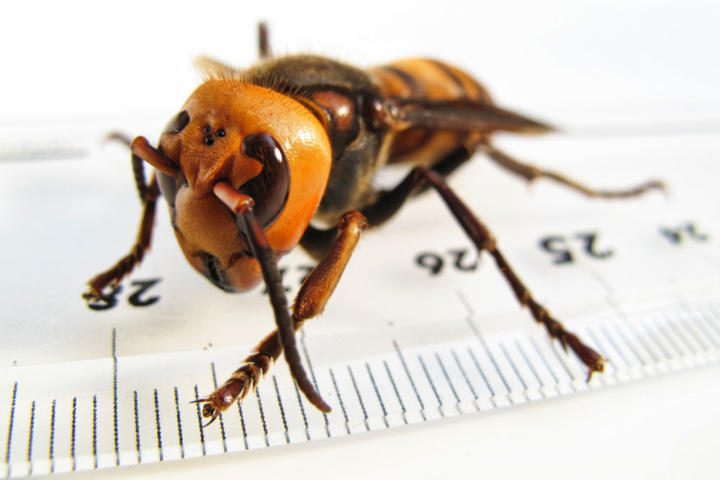

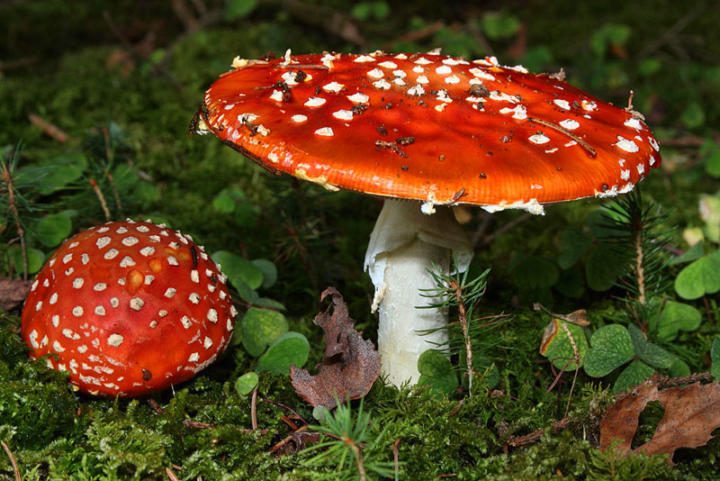
omg! i cant beleive what you all have been through. I live in Az where there is no beach. i read a book that had some facts on jellyfish, so i was interested. I could never imagine befing stung by one though. Glad you are all safe and well now!
I was stung by a man-of-war when I was a teenager, surfing near Galveston, Texas. It was just one little sting on my thumb, but the pain was immense, and my whole arm soon was paralyzed for about 4 hours. That was the last time I went surfing when they were in the water.